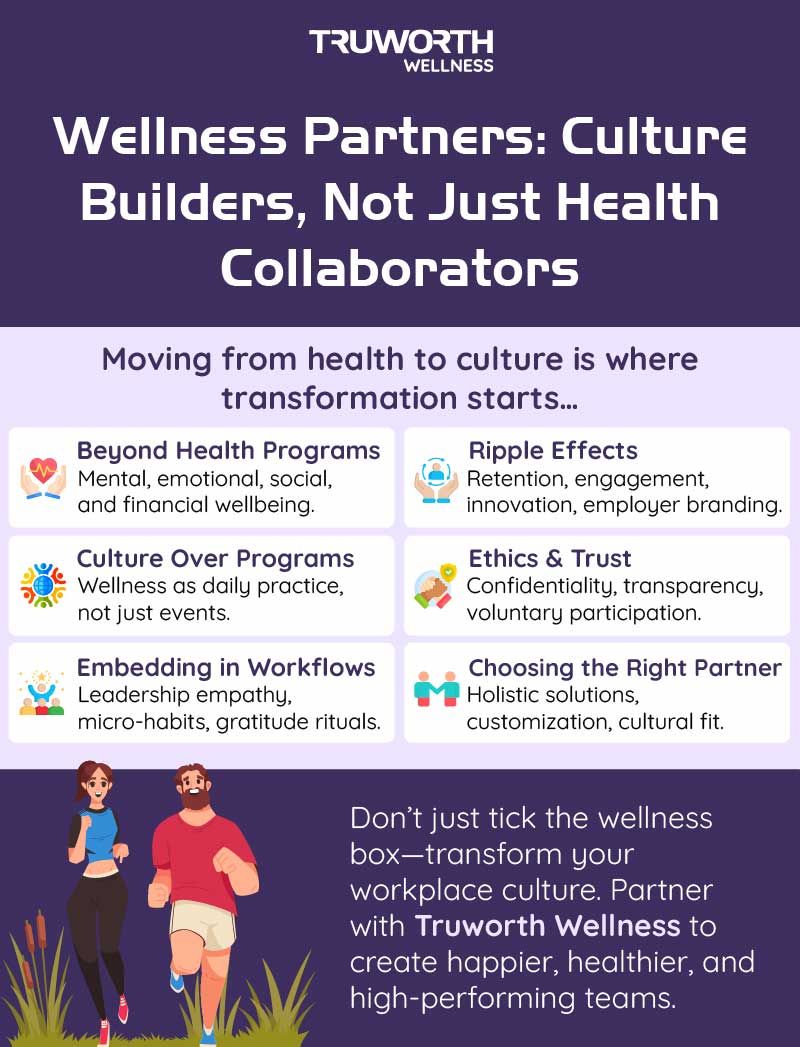Why Your Wellness Partner Should Be A Culture Builder? (Not Just A Health Partner)

Companies have realized that employee well-being directly impacts productivity, retention, and organizational success. But here’s the catch: the role of wellness partners has expanded far beyond simply managing health checkups or running yoga sessions. They are now emerging as true culture builders, shaping how organizations think, feel, and function every day.
The traditional image of wellness partners often revolves around gym tie-ups, diet plans, or annual health camps. While these services are important, they only scratch the surface of what modern wellness collaboration should achieve. In reality, a good wellness partner helps organizations weave wellbeing into the cultural fabric of the workplace, transforming it into a sustainable way of life rather than a one-off initiative.
Let’s explore how wellness partners act not just as health collaborators but as culture architects, and why companies should rethink the way they work with them.
Also Read: What You Need To Keep In Mind When Building Your Workplace Wellness Culture?

1. Moving Beyond Health: Redefining the Role of Wellness Partners
When companies partner with wellness providers, the usual expectation is to reduce absenteeism, manage stress, and promote healthy living. But in a hypercompetitive environment, employees want more than just a health policy—they want a workplace that supports their overall life experience.
Wellness partners today bring a 360-degree approach, integrating:
- Mental Health Support – Counseling, therapy access, stress management workshops.
- Emotional Fitness – Building resilience, empathy, and interpersonal harmony at work.
- Social Wellbeing – Encouraging collaboration, kindness, and inclusivity.
- Financial Wellness – Guiding employees through savings, planning, and debt management.
- Purpose-driven Engagement – Aligning personal values with organizational goals.
This expanded scope turns wellness providers into cultural stakeholders, not just health consultants.
2. Why Culture Building Matters More Than Programs?
A culture of wellness is different from a wellness program. Programs may attract participation, but culture ensures sustained adoption. For instance:
- A yoga session once a week is good, but when mindfulness becomes a part of daily team rituals, it creates impact.
- Financial literacy workshops help, but when open conversations about money stress are normalized, employees feel safe and supported.
- Diversity sessions matter, but when inclusivity is woven into leadership behaviors, it fosters belonging.
Wellness partners who focus on culture help organizations move from checklists to mindsets—from “what activities did we do this quarter?” to “how do our people feel working here every day?”
3. Embedding Wellness into Everyday Practices
Culture isn’t built in grand boardrooms—it’s nurtured in everyday actions. Wellness partners can play a transformative role by embedding wellness into the daily rhythm of work:
- Leadership Coaching: Training managers to recognize burnout signals and respond with empathy.
- Micro-habits Integration: Introducing simple nudges like screen breaks, walking meetings, or digital detox hours.
- Team Rituals: Encouraging gratitude circles, kindness challenges, or weekly wellbeing check-ins.
- Technology Support: Using apps and dashboards to make wellness resources accessible on demand.
By blending wellness with the flow of work, partners help organizations create a culture where well-being isn’t an event but a habit.
4. The Ripple Effect of Culture-Oriented Wellness
When wellness becomes cultural, its impact spreads beyond health statistics. Some ripple effects include:
- Higher Retention: Employees stay longer in organizations that care about their holistic well-being.
- Stronger Engagement: People perform better when they feel valued and supported.
- Innovation & Collaboration: A culture of psychological safety encourages creativity and teamwork.
- Employer Branding: Companies known for wellness attract top talent in competitive markets.
Wellness partners, therefore, don’t just improve health; they help build workplaces where people thrive.
5. The Ethical Side: Trust and Data Responsibility
As wellness partners expand their role, they also gain access to sensitive employee data, ranging from mental health concerns to lifestyle patterns. This makes ethics and confidentiality non-negotiable. Culture-driven wellness partnerships must prioritize:
- Confidentiality: Ensuring no personal data is misused or disclosed.
- Transparency: Clearly communicating how data is collected and used.
- Voluntariness: Making programs opt-in rather than forced participation.
Trust is the foundation of a wellness-driven culture, and partners must safeguard it diligently.
6. Real-World Example: Culture in Action
Imagine two companies offering similar wellness programs—yoga sessions, EAPs, and health screenings.
- Company A treats wellness as a box-ticking exercise. Employees attend sessions but rarely engage deeply. Stress remains high, and turnover continues.
- Company B, guided by a culture-focused wellness partner, trains leaders to open meetings with a two-minute reflection, sets boundaries for after-hours emails, and encourages peer appreciation rituals. Over time, employees feel cared for and supported. Productivity rises, and people stay longer.
Both had wellness programs, but only one built a culture of wellness—and the difference is transformational.
7. How Organizations Can Choose the Right Partner?
Not every wellness provider is equipped to shape culture. To find the right fit, organizations should look for partners who:
- Offer comprehensive wellbeing solutions (mental, physical, social, and financial).
- Focus on long-term behavioral change, not just short-term participation.
- Provide data-driven insights while respecting privacy.
- Customize programs for cultural and regional relevance.
- Act as strategic advisors, aligning wellness with business and HR goals.
The right partner doesn’t just deliver activities—they co-create culture with leadership.
Final Thoughts
In a world where burnout is rampant and employee expectations are rising, wellness cannot be an isolated HR function. It has to be part of the culture—something employees experience every day, not just during annual wellness weeks.
Wellness partners, when chosen wisely, can become true culture builders, reshaping how organizations think about success, performance, and human connection. They are no longer just collaborators in health—they are co-architects of workplace happiness, resilience, and belonging.
How Truworth Wellness Helps Build Cultures, Not Just Programs?
At Truworth Wellness, we believe employee wellbeing is not a one-time project; it’s a cultural shift. Our holistic programs integrate physical health, emotional resilience, financial well-being, and social connection into the everyday lives of employees. From AI-powered health platforms to expert-led workshops and confidential counseling, we help organizations embed wellness into their DNA.
If you’re ready to go beyond health checkups and create a workplace where people truly thrive, partner with Truworth Wellness today. Together, let’s build not just healthier employees, but stronger cultures.